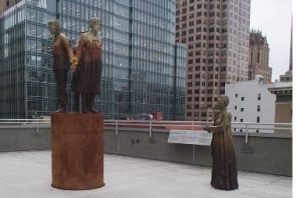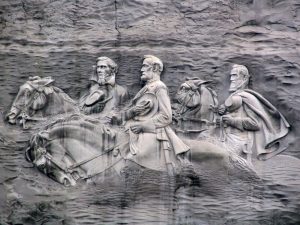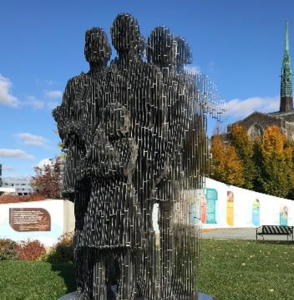1 Research
Assess the community’s history, politics, law, concerns, identities, divisions, and aspirations as these relate to goals, process, timing, stakeholders, and policies going forward (Points 2-9) for improving symbols and public spaces.
POSSIBLE STRATEGIES
Assemble or consult with people who together can take stock of your community, especially members of the community who can affect the changes that would improve the environment and help to design the process for making those changes.
Consider the community’s and nation’s history as that provides a basis for identifying a common identity, shared aspirations, and inspiration. Also examine the reasons that painful memories may continue to trouble or harm some in the community or may yield lessons that ought to be taught through relocation of symbols, provision of context, creation of new spaces, and more. “Understand that different perceptions and interpretations exist,” the latter a principle developed for remembering in Northern Ireland.[2]
Assess community members’ concerns, interests, identities, and divisions to provide a foundation for setting goals for improving the environment and for appreciating the realities of how a proactive process can achieve those goals. Consider divisions that might be bridged through changes in the environment that promote mutual understanding, demonstrate respect, and bring people together across these fault lines. Take account of inequalities in resources and communication. Be aware that some groups might feel intimidated.
Look for instances in which community members disagree on the facts that might form a rationale for changing the environment. Recognize that historical research can provide an opportunity to establish and communicate accurate facts.
Search for matters of cultural importance to groups within the community, as a basis for finding ways to honor these topics in the environment and improve their sense of belonging of these groups.
Watch for national or local events that galvanize interest in change such that in the aftermath of these events more public officials and community members may find the time and resources required to improve symbols and public spaces (see Timing).
Research legal requirements that might affect the process and the likelihood of implementing change and maintaining the change over time. Pertinent laws might include Heritage Acts that sometimes require super majorities of public bodies before changing public monuments, laws authorizing university boards of trustees to act, the Visual Artists Rights Act, various copyright laws, relevant executive or court orders, and legal enforcement of donors’ agreements. Reflecting an illustration of how changes in law may affect the permanence of symbols modifications, President Donald J. Trump issued an executive order just months after beginning his second term related to various federal properties, Independence Hall, and the Smithsonian Museum. Section 4 directs the Secretary of Interior to restore any symbols removed or modified after January 1, 2020 (during the prior administration) on properties within the U.S. Department of Interior’s jurisdiction if the changes were made “to perpetuate a false reconstruction of American history, inappropriately minimize the value of certain historical events or figures, or include any other improper partisan ideology” and to assure that symbolic aspects of Department of Interior properties do not “inappropriately disparage Americans past or living … and instead focus on the greatness” of the nation.[3] In addition to helping to avoid implementation issues and anticipate permanence issues, legal research might open the possibility of developing laws or policies regarding public spaces going forward that are more closely attuned to current goals.
Consider the political landscape as it relates to implementation of change in symbols and public spaces and the reactions to the changes. The research might, for example, indicate political differences between cities and the counties or states in which they reside. These political differences may translate into backlash and new roadblocks related to changes in symbols and public spaces.
ILLUSTRATIONS
Creating standing processes to consider ideas for change
In 2019, Providence (RI) passed an ordinance that established an advisory committee, the Special Committee to Review Commemorative Works, that was designed to review and advise the city council on the “thousands of commemorative monuments and memorials that are displayed through the city” as well as on proposals for new commemorative works.[4] In 2021, the committee issued a draft for comment that lists what it heard, its vision for 2031, and its top strategies.[5]
New discoveries that propel busy people to devote time and resources to a process for improving symbols and public spaces
Sometimes the assessment will surface or provide focus on an event that galvanizes interest, suggesting that this is the right time to begin a proactive symbols/public spaces process. For example, a recently discovered burial site contained remains of indigenous children at what was Canada’s largest boarding school. The Chair of the Truth and Reconciliation Commission of Canada described what occurred in these boarding schools in an interim report: “Removed from their families and home communities, seven generations of Aboriginal children were denied their identity through a systematic and concerted effort to extinguish their culture, language, and spirit.”[6] The discovery sparked a deeper discussion of similar practices in the United States.
In response, U.S. Secretary of the Interior Deb Haaland launched the Federal Indian Boarding School Initiative. Volume I of the investigative report was released in 2022[7]; Volume II followed in 2024.[8] Together, the reports identified 417 federal boarding schools, at least 973 student deaths, and 74 marked or unmarked burial sites, along with detailed documentation of the intergenerational trauma caused by forced removal, family separation, and cultural suppression. The Department of the Interior acknowledged that many children never returned home, and the actual number of deaths is likely far higher. The reports also recognized the U.S. government’s partnerships with religious institutions and called for a national reckoning.
Assistant Secretary for Indian Affairs, Bryan Newland emphasized that the investigation must be paired with action. “These institutions are not just part of our past,” she noted, “their legacy reaches us today.”[9] The findings spurred renewed discussions around memorialization, naming practices, and the need for truth-telling in public space design—often prompting local leaders to reexamine how official narratives are conveyed through monuments, place names, and other public symbols.
Careful preparation on legal limitations that may open avenues for changing the environment
During the Reconstruction Era after the Civil War, white citizens within the former Confederate states resisted the changes and established a number of memorials to the Confederacy. During that time, Virginia residents erected in Richmond, the former capital of the Confederacy, a 60-foot-tall pedestal and statue of Confederate military commander Robert E. Lee. In 1890, the Virginia legislature and governor accepted the deed to the land and statue and agreed to a deed covenant stipulating that the statue should not be removed – in perpetuity. Leading up to the decision, legal research for arguing that the state should not be required to enforce the restrictive covenants. The deed provisions did not prevent the Governor from removing the Robert E. Lee statue in 2021, the Supreme Court of Virginia ruled unanimously. The justices held, “[T]hose restrictive covenants are unenforceable as contrary to public policy and for being unreasonable because their effect is to compel government speech, by forcing the Commonwealth to express, in perpetuity, a message with which it now disagrees.”[10]
Unlike governments that removed monuments without public notice to avert violence, Virginia Governor Ralph Northam announced the date of removal about two days ahead. On September 8, 2021, Governor Northam and a peaceful crowd watched as the state removed the statue and the attendees began singing, “Hey, hey, hey, goodbye.”[11] The Virginia legislature asked the Virginia Museum of Fine Arts (VMFA) to solicit public and expert opinion to recommend a new approach to the corridor formerly displaying Confederate monuments.[12] While the VMFA did not release the report publicly, the museum issued general guidance on the accurate and respectful interpretation of history, including recontextualization, community dialogue, partnership with interested organizations, and the prioritization of new public art.[13]

Anticipating resistance to change and adjusting the deliberative process to promote discussion
In 2017, a University of California-Berkeley School of Law professor noticed and announced that namesake of the law building, Boalt Hall, had written articles supporting the Chinese Exclusion Act of 1882 and promoting hate of persons of Chinese descent. UC’s Chancellor appointed a Building Name Review Committee, which in 2019 recommended removing the name from the school but also that the law school “present the relevant history.” A new law school committee then began educating the community. By 2020, when the university removed the name from the law school, the decision was broadly supported. The professor who noticed the history said that he “never sought to erase history. To the contrary. I did everything I could to broadcast it.”[14] In 2021, the law school community worked on a mural to celebrate its current values.
Proactive planning

The Smithsonian American Art Museum conducted an art inventory in 2011 that concluded women were depicted in only 8 percent of the 5,193 U.S. public outdoor sculptures. The relatively small number of statues of women included Alice in Wonderland, Shakespeare’s Juliet, and Mother Goose. A group formed to honor women suffragists. Over years and with multiple concepts debated, the sculpture unveiled in New York City’s Central Park in 2020 depicted Sojourner Truth, Susan B. Anthony, and Elizabeth Cady Stanton talking together. The controversies continue, though commentators acknowledge that a monument with “real women” matters in terms of making women feel valued. The design has led to discussions that help people better understand the fraught positioning on race and gender among those gaining passage of the 15th and 19th Amendments to the U.S. Constitution.[15]
An illustration of complex, competing political consequences
In 2015, a campaign emerged to use symbols to educate and trigger reflection on the brutal realities of the sexual enslavement of girls and women in Japanese-occupied nations before and during World II. As a result, the San Francisco Board of Supervisors decided to create a memorial to these women. The unveiling of the statue, “Comfort Women: Pillar of Strength,” in 2017 led to a protest from the mayor of San Francisco’s sister city in Japan and in 2018 to that city terminating the sister city status. The Japanese government maintained that it apologized for wartime acts and paid reparations to the Korean government several decades ago. The Korean government received compensation from Japan but did not distribute them to the original victims. Activists in the U.S. and Korea continue to demand individual compensation, and that group has funded comfort women statues in other locations. Locally, most Japanese Americans supported the memorial, though some Japanese Americans, particularly recent immigrants, opposed it.[16]
Deep Dive: Stone Mountain, Georgia
Thorough research into a community’s historical narratives, legal landscape, and political dynamics before launching any process related to symbols or public spaces can help to avoid missteps. At first glance, one might view the Stone Mountain sculpture described below as simply another Confederate monument that might be either ignored or moved. But research would reveal what is described below — that deeply layered histories can shape public meaning—and public resistance. Even with research, planners might make some errors, but understanding the nuances early helped the Stone Mountain board bring more of the community with them as they made decisions and will assist them in the future.
Self-described as “Atlanta’s Favorite Destination for Family Fun,” Stone Mountain Park in Georgia features the world’s largest high relief sculpture.[17] This monumental carving sits 400 feet above ground and spans 90 feet in height and 190 feet in width. It was completed in 1972 after more than five decades of work. Entitled the “Confederate Memorial Carving,” the sculpture portrays three Confederate figures, President Jefferson Davis, and Generals Robert E. Lee and Thomas J. “Stonewall” Jackson, on horseback. Despite the park’s self-description as a place of family fun, some residents, visitors and community organizations remember a history of the Confederate Memorial Carving that is steeped in white supremacy.
In 1905, United Daughters of the Confederacy (UDC) members sought to construct a Confederate monument representing the “Lost Cause,” an idea that the Confederacy’s defeat was due to the overwhelming Union advantage in manpower and resources, but that the Confederacy had fought nobly for its ideals.[18] The “Lost Cause” interpretation of the Civil War also nostalgically celebrates an antebellum South of supposedly benevolent slave owners and content enslaved people, while downplaying or altogether ignoring chattel slavery as the cause of the Civil War.

In 1915, the Stone Mountain venue became inextricably linked to white supremacy. Following the release of the infamous film “The Birth of a Nation,” a former Methodist minister saw it as an opportunity to revive interest and membership in the Ku Klux Klan (KKK). On Thanksgiving 1915, days before the film premiered in Atlanta, he led a group of fifteen men in robes and hoods up the side of Stone Mountain. Atop Stone Mountain, the group ignited a cross and proclaimed the rebirth of the KKK.[19] On the opening night of the film’s premiere in Atlanta, Klansmen wore white sheets and Confederate uniforms as they rode hooded horses down Peachtree Street and fired rifle salutes in front of the theater.[20] Shortly thereafter, the owners of Stone Mountain granted the KKK easements to use the mountain for rituals and deeded the north face of the mountain to the UDC for the purpose of constructing a sizable Civil War monument.[21] The land became the KKK’s “Imperial Palace” used for initiations and other Klan meetings.
To further enmesh Stone Mountain with the KKK, a Klan leader sought to include Klan members in the carving to pay tribute to their “heroics.”[22] However, construction of the Confederate Memorial Carving ground to a halt in 1928 after the UDC struggled to secure stable funding. Following the Brown v. Board of Education decision in 1954, and to resist federally mandated integration and civil rights measures, in 1958, the State of Georgia purchased the mountain with the intention of resuming the carving. The monument was officially dedicated in 1970, and finally completed in 1972. To preserve its legacy, the Georgia legislature codified law establishing the Stone Mountain Memorial Association and mandating that it “maintain an appropriate and suitable memorial for the Confederacy.”[23]
Public controversy about the Stone Mountain’s historical significance resurfaces from time to time. Some groups, including Confederate heritage groups and the Sons of Confederate Veterans, are insistent that the monument remain, while others, including the Southern Christian Leadership Conference, want all references to the Confederacy removed from Stone Mountain . Some urge a boycott – people who will not engage with anything related to Stone Mountain or those who do business there. Another group is adamant that Stone Mountain site be changed to make it more welcoming to all persons. They see it as a symbol of hate that could, if placed in context, become a symbol of remembrance. In 2015, in an effort to compromise, state leaders approved placing a bell at the top of Stone Mountain to honor Dr. Martin Luther King Jr.’s 1963 call to “let freedom ring from Stone Mountain of Georgia” during his “I Have a Dream” speech.[24] However, this was met with staunch criticism by people of varying perspectives agreeing that Stone Mountain is not an appropriate place to honor Dr. King’s civil rights legacy.
On July 4, 2020, about 1,000 heavily armed members of an all-Black militia marched to Stone Mountain to demand that the carving be removed. The group marched peacefully and the leader commended Stone Mountain Police Department officers for providing them the space to express their First Amendment right to freely assemble. A Stone Mountain spokesman said, “It’s a public park, a state park. We have these protests on both sides of the issue from time to time. We respect people’s First Amendment right.”[25]
The Stone Mountain governing board may have the power to contextualize Stone Mountain’s historical ties to white supremacy, and leaders continue to search for approaches that will resolve the symbols conflict. On January 15, 2023, the Stone Mountain City Council unveiled street sign toppers honoring Martin Luther King Jr. There has not been sufficient political support to change the Georgia law requiring the Confederate flag to be raised at Stone Mountain, but later in 2023 , the four Confederate Flags flying at the Stone Mountain trailhead were moved to the base of the monument where they can be viewed in the context of the memorial.
- Danae King, Social Justice Park Sculpture Intended to Inspire Unity, Social Change, Columbus Dispatch (Feb. 1, 2021). Photo by Nancy Rogers.(with permission from the Greater Columbus Arts Council). ↵
- Principles for remembering in Northern Ireland recorded at https://www.community-relations.org.uk/files/communityrelations/media-files/Decades-principles-2021.pdf. See also Johnston McMaster & Maureen Hetherington, Ethical & Shared Remembering: Remembering a Decade of Change and Violence in Ireland 1912-1922, https://thejunction-ni.org/wp-content/uploads/2019/08/remembering-a-decade.pdf. ↵
- Donald J. Trump, Executive Order, Restoring Truth and Sanity to American History, § 4 (March 27, 2025), https://www.whitehouse.gov/presidential-actions/2025/03/restoring-truth-and-sanity-to-american-history/ ↵
- Mayor, City of Providence Leaders Collaborate to Form Special Committee to Address Commemorative Works, City of Providence (Nov. 14, 2019), https://www.providenceri.gov/mayor-city-providence-leaders-collaborate-form-special-committee-address-commemorative-works/. ↵
- City of Providence Department of Art, Culture & Tourism, A Cultural Plan for Culture Shift (June 2021 Draft), https://docs. google.com/document/d/1TUEv4ZlvANfAYddIbZZDjH7paKD0dNaFBUdqQo-bWj0/edit. ↵
- Statement from the Chair, Justice Murray Sinclair, The Final Report of the Truth and Reconciliation Commission of Canada vii (2015). ↵
- Volume 1 of the Department of the Interior’s Federal Indian Boarding School Initiative Investigative Report, U.S. Department of the Interior, (June 22, 2022), https://www.congress.gov/117/chrg/CHRG-117shrg50193/CHRG-117shrg50193.pdf. ↵
- Federal Indian Boarding School Initiative Investigative Report Vol. II, U.S. Department of the Interior, (July 2024), https://www.bia.gov/sites/default/files/media_document/doi_federal_indian_boarding_school_initiative_investigative_report_vii_final_508_compliant.pdf. ↵
- Interior Department Announces Partnerships to Memorialize Stories and Impacts of Federal Indian Boarding School System, U.S. Department of the Interior, (December 9, 2024), https://www.doi.gov/pressreleases/interior-department-announces-partnerships-memorialize-stories-and-impacts-federal. ↵
- Taylor v. Northam, No. 210113, 2021 WL 3918940 (Va. Sept. 2, 2021) (unanimous). ↵
- Alexadra Hutzler, Richmond Crowd Cheers as Robert E. Lee Statue Removed: “Hey Hey Hey, Goodbye!’, Newsweek (Nov. 7, 2021), https://www.newsweek.com/richmond-crowd-cheers-robert-e-lee-statue-removed-hey-hey-hey-goodbye-1627050. ↵
- Gregory S. Schneider & Laura Vozzella, Robert E. Lee Statue Is Removed in Richmond, Ex-Capital of Confederacy, After Months of Protests and Legal Resistance, Washington Post (Sept. 8, 2021), https://www.washingtonpost.com/local/virginia-politics/robert-e-lee-statue-removal/2021/09/08/1d9564ee-103d-11ec-9cb6-bf9351a25799_story.html. ↵
- VMFA and Confederate History, Virginia Museum of Fine Arts, (November 10, 2011), https://vmfa.museum/connect/vmfa-and-confederate-history. ↵
- Gretchen Kell, UC Berkeley Removes Racist John Boalt’s Name from Law School, Berkeley News (Jan. 30, 2020), https:// news.berkeley.edu/2020/01/30/boalt-hall-denamed/. ↵
- Nora McGreevy, Why the First Monument of Real Women in Central Park Matters—and Why It’s Controversial, Smithsonian Magazine (Aug. 26, 2020), https://www.smithsonianmag.com/smart-news/monument-controversy-women-pioneer-central-park-180975662/. ↵
- See, e.g., Christine Hauser, “It Is Not Coming Down’” San Francisco Defends “Comfort Women” Statue as Japan Protests, New York Times (Oct. 4, 2018), https://www.nytimes.com/2018/10/04/us/osaka-sf-comfort-women-statue.html; Sasha Ingbar, Osaka, Japan, Ends Ties with San Francisco in Protest of “Comfort Women” Statue, NPR (Oct. 4, 2018), https://www.npr.org/2018/10/04/654474739/osaka-ends-ties-with-san-francisco-in-protest-of-comfort-women-statue; Interview with Ron Wakabayashi, former executive director, Japanese-American Citizens League, Sept. 8, 2021. ↵
- “Stay and Play,” Stone Mountain Park, https://stonemountainpark.com/. ↵
- “Memorialization of Robert E. Lee and the Lost Cause,” Arlington House, the Robert E. Lee Memorial (National Park Service), last modified September 14, 2021, https://home.nps.gov/arho/learn/historyculture/memorialization-of-robert-e-lee-and-the-lost-cause.htm. ↵
- “Nation: The Various Shady Lives of the Ku Klux Klan,” Time Magazine, April 9, 1965, https://time.com/archive/6833568/nation-the-various-shady-lives-of-the-ku-klux-klan/. ↵
- “The Connection Between the United Daughters of the Confederacy and the KKK,” Atlanta History Center, December 9, 2022, https://www.atlantahistorycenter.com/blog/the-connection-between-the-united-daughters-of-the-confederacy-and-the-kkk/. ↵
- Benjamin Powers, “In the Shadow of Stone Mountain,” Smithsonian Magazine, May 4, 2018, https://www.smithsonianmag.com/history/shadow-stone-mountain-180968956/. ↵
- “Monument: The Untold Story of Stone Mountain,” Atlanta History Center, https://www.atlantahistorycenter.com/monument/. ↵
- GA Code § 12-3-192.1 (2022). ↵
- Ernie Suggs, “Birth of an Idea: Where the King Monument on Stone Mountain Came From,” The Atlanta Journal Constitution, January 15, 2017, https://www.ajc.com/news/local/birth-idea-where-the-king-monument-stone-mountain-came-from/HFpAfVTvdwvTXR4Td6UjHP/. ↵
- Benjamin Fearnow, “Armed Black Militia Challenges White Nationalists at Georgia’s Stone Mountain Park,” Newsweek, July 5, 2020, https://www.newsweek.com/armed-black-demonstrators-challenge-white-supremacist-militia-georgias-stone-mountain-park-1515494. ↵

